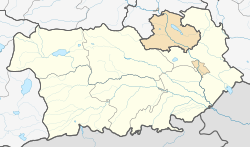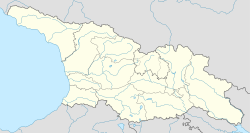| This article needs additional citations for verification. Please help improve this article by adding citations to reliable sources. Unsourced material may be challenged and removed. Find sources: "Sameba, Georgia" – news · newspapers · books · scholar · JSTOR (October 2021) (Learn how and when to remove this message) |
| Sameba Georgian: მარანი | |
|---|---|
| Village | |
 View of the Landscape of Sameba Village, Kvemo Kartli, Georgia View of the Landscape of Sameba Village, Kvemo Kartli, Georgia | |
  | |
| Coordinates: 41°35′59″N 44°0′21″E / 41.59972°N 44.00583°E / 41.59972; 44.00583 | |
| Country | |
| Region | Kvemo Kartli |
| Municipality | Tsalka Municipality |
| Population | |
| • Total | 693 |
| Time zone | UTC+4 (Georgian Time) |
Sameba (Georgian: სამება [sameba]; formerly Gunia-Kala, Kastron; Greek: Γκουνιά-Καλά, Κάστρον; Georgian: გუნიაკალა [ɡuniɑkʼɑlɑ]) is a predominantly Greek village in Tsalka Municipality, Georgia.
History
The village was founded in 1830 by Pontic Greeks from a village of the same name in the Trebizond Vilayet in the Ottoman Empire.
Sameba is located 5 kilometers to the west of the city of Tsalka, which is the district's main city. In the 1930s one could still find older residents speaking the Pontic dialect of Greek. After the Second World War some people in the village retained the language, but the rest switched to speaking Turkish and Russian.
By the time of the collapse of the USSR there were about 700 households in Gunia-Kala, in which there lived more than 2000 people. In 2002 236 residents remained in the village, 72% of which were Greeks and 18% Georgians.
See also
References
- "Population Census 2014". www.geostat.ge. National Statistics Office of Georgia. November 2014. Retrieved 28 June 2021.
This Georgia location article is a stub. You can help Misplaced Pages by expanding it. |